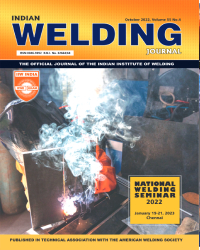Laser Welding at Low Pressures
Subscribe/Renew Journal
Laser welding as an industrial joining process is perhaps no more than 20 years old, yet it has already developed to a stage where it provide direct competition to conventional welding processes and even to the electron beam welding (EBW) (1). The tremendous capabilities of the laser originate from its high energy density and fine focusibility obtained during the process of welding. Laser energy is absorbed by the surface of the weld joint and conducted away from the metal surface. The thermal processes taking place are markedly different as the energy density is varied starting from radial conduction to vaporization conduction to vapourisation loss to plasma formation over the sample.
User
Subscription
Login to verify subscription
Font Size
Information

Abstract Views: 348

PDF Views: 4



